#Freycinet National Park
Text
Tasmanian Photography Locations
I’m often asked by photographers on where is best to photograph in Tasmania. This is a small list of photographic locations that I’d recommend checking out while in Tasmania. I’m aware that there is many locations missing from this list but that’s because I’m yet to photograph them so will update the list accordingly. Also most of these locations should suit most people as they’re quite…

View On WordPress
#"Tasmania photography locations"#Alex Wise#Arthur River#Australia#Clifton#coles bay#Cradle Mountain#dove lake#Freycinet National Park#Friendly Beaches#Goats#Hobart#Lauderdale#Lion Rock#locations#Lumpies#Marrawah#mental hospital#Mortimer Bay#Mount Field#nature photography#park beach#photography#photography blog#Queenstown#Rebounds#reflections#RSLS#Russel Falls#Sandpits
9 notes
·
View notes
Text
Exploring Paradise: Unveiling the Wonders of Wineglass Bay, Tasmania Through Guided Tours
Nestled along the pristine shores of the Freycinet Peninsula in Tasmania, Wineglass Bay stands as a natural masterpiece, captivating travelers with its crystal-clear waters, ivory sands, and rugged coastal beauty. To truly immerse oneself in the enchantment of this iconic destination, guided tours to Wineglass Bay offer an unparalleled experience. This article delves into the allure of Wineglass Bay Tasmania tours and the enriching journeys provided by guided tours in Tasmania.
**1. Natural Beauty Beyond Compare:
Wineglass Bay is renowned for its crescent-shaped beach, often hailed as one of the world's most beautiful. Guided tours ensure that visitors not only witness this natural marvel but also gain insights into its geological formation, local flora and fauna, and the significance of its pristine ecosystem.
**2. Expert-Led Exploration:
Guided tours to Wineglass Bay are led by knowledgeable and experienced guides who share their passion for Tasmania's natural wonders. These experts provide valuable context, historical anecdotes, and ecological information, turning the excursion into an educational and immersive journey.
**3. Scenic Hiking Trails:
Many Wineglass Bay tours include scenic hiking trails that offer panoramic views of the bay and its surroundings. Whether ascending to a lookout point or traversing coastal paths, guided hikes provide a closer connection to the landscape, allowing participants to appreciate its grandeur.
**4. Wildlife Encounters:
Tasmania is home to unique and diverse wildlife, and Wineglass Bay tours often include opportunities to encounter native species. From wallabies and wombats to a variety of birdlife, the guided experience extends beyond the bay itself to the captivating biodiversity of the region.
**5. Cruises and Water Adventures:
Some guided tours offer the option of exploring Wineglass Bay from the water. Cruises provide a different perspective, allowing participants to appreciate the bay's contours, sea caves, and marine life. Kayaking adventures offer a hands-on experience for those seeking a more active exploration.
**6. Cultural Insights:
Tasmania's rich indigenous history adds layers of cultural significance to Wineglass Bay. Guided tours often incorporate cultural insights, sharing stories of the region's Aboriginal heritage and the deep connection the indigenous people have with the land.
**7. Photographic Opportunities:
The breathtaking landscapes of Wineglass Bay are a photographer's dream. Guided tours provide ample opportunities for capturing the beauty of the bay, its changing hues, and the play of light and shadow, ensuring that participants leave with lasting memories in the form of stunning photographs.
**8. Group Dynamics and Camaraderie:
Joining a guided tour fosters a sense of camaraderie among participants. Shared experiences, group discoveries, and the camaraderie of exploring Wineglass Bay together create a unique bond among travelers, enhancing the overall enjoyment of the journey.
Conclusion: A Guided Odyssey Through Wineglass Bay's Splendor:
Wineglass Bay is more than a destination; it's a testament to the extraordinary beauty that Tasmania harbors. Guided tours elevate the experience, transforming a visit into an immersive and enlightening journey. From knowledgeable guides to diverse activities, these tours weave together the elements that make Wineglass Bay an enduring marvel.
Whether it's the serenity of the bay, the thrill of exploration, or the stories that echo through its coastal cliffs, Wineglass Bay beckons travelers to discover its secrets. Guided tours provide the ideal avenue for those seeking not just a sightseeing excursion but a transformative odyssey through one of Tasmania's most cherished gems.
For more details, visit us :
How to visit Bay of Fires Tasmania
Tasmania Private ToursTop of Form
Wild Tasmania Tours
0 notes
Text

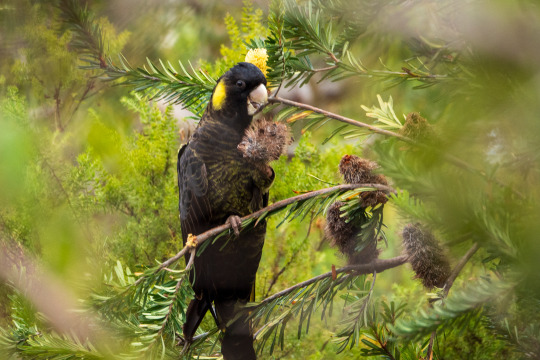
Yellow-tailed black-cockatoo (Zanda funerea), Freycinet National Park, Tasmania, Australia
20 notes
·
View notes
Text






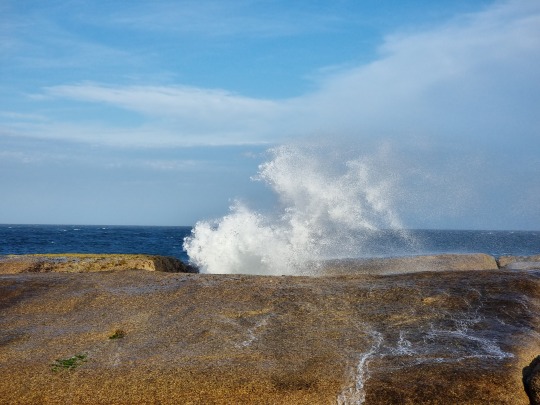



Photos from Day 7 of Australia Vacation (Freycinet National Park and Bicheno)
Top photo: snake on a bench next to the trail up to the Wineglass Bay Lookout in Freycinet National Park
Row 2: Wineglass Bay Lookout view
Row 3: Lighthouse and park logo
Row 4: view from Lobster Shack. So many birds I couldn't identify on that islet and in the air and water! It was really really windy. I saw a welcome swallow feeding its young in a nest under the eaves of the building, and when it flew out to catch more insects the wind blew it away really dramatically!
Row 5: Bicheno coastline view; blowhole
Row 6: Little Penguin mural
Row 7: Little Penguins!
#personal#travel#photography#birdwatching#wildlife#full disclosure: some of these photos are by sister in law
11 notes
·
View notes
Text
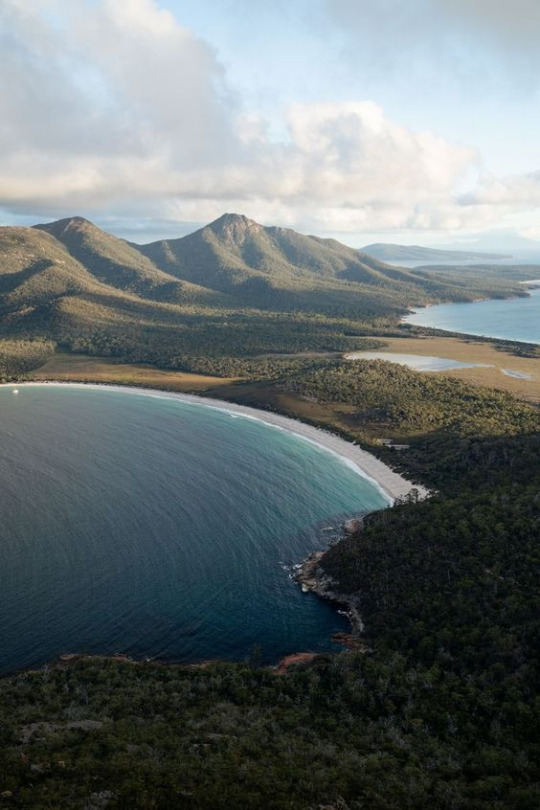

Wineglass Bay, Freycinet National Park, Tasmania
Tasmania, where the poet was born
Possible inspiration for the "lagoon" mentioned in the poem
-Wendy
0 notes
Text
An Australian Art image of a Red-necked Wallaby, in Freycinet National Park. The scene is enriched by the distinctive qualities of Indigenous Australian Art, with its intricate dot patterns and earthy hues. The Wallaby, a unique species with its reddish fur and agile form, is depicted using natural ochres and bark. The artwork, while concise, captures the essence of the Wallaby and the breathtaking beauty of the park.
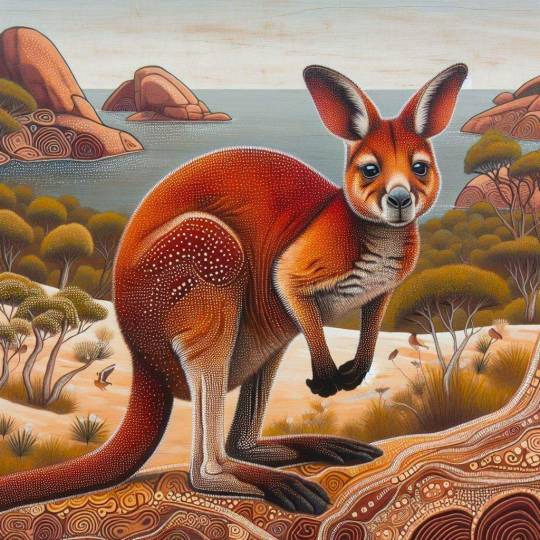
0 notes
Text
The top seven stunning national parks in Australia
Australia, with its wide and diverse landscapes, is home to some of the world's most beautiful national parks, each highlighting the continent's rich natural history. These protected areas not only preserve distinct ecosystems but also allow tourists to experience the spectacular beauty of Australia's various settings. From the tropical marvels of Kakadu National Park in the Northern Territory to the undersea extravaganza of the Great Barrier Reef Marine Park in Queensland, Australia's national parks represent a diverse range of habitats. The ancient landscapes of New South Wales' Blue Mountains fascinate with their towering cliffs and eucalyptus-filled valleys, while Uluru-Kata Tjuta National Park, in the country's red center, bears spiritual importance with spectacular geological features.
Traveling north to Queensland, Daintree National Park offers a view into ancient rainforests that meet the pristine seas of the Great Barrier Reef. Tasmania's Freycinet National Park is home to breathtaking coastline scenery and the world-famous Wineglass Bay. Meanwhile, the Grampians National Park in Victoria protects steep sandstone mountains and Aboriginal cultural sites. In this introduction, we will take a tour around Australia's spectacular national parks, each of which offers a distinct tableau of natural beauty, cultural value, and outdoor activity. From coast to desert, rainforest to mountain range, these national parks beckon exploration and offer extraordinary experiences with the breathtaking landscapes that characterize Australia's limitless splendor.
Here are some stunning national parks in Australia.
1. The Northern Territory's Kakadu National Park: Stunning Biodiversity: Kakadu National Park, one of Australia's most diversified ecosystems, is a UNESCO World Heritage Site that covers almost 20,000 square kilometers. The park is home to an amazing variety of plants and animals, including the famed Yellow Water Billabong and the ancient Aboriginal rock painting at Nourlangie Rock. The rich Aboriginal culture that has flourished in the area for thousands of years may be experienced by visitors as they explore the verdant landscapes, wetlands, and tumbling waterfalls.
2. Queensland's Great Barrier Reef Marine Park: Underwater Wonderland: Stretching over 2,300 kilometers along the Queensland coast, the Great Barrier Reef Marine Park is a wonder recognized by UNESCO. This underwater paradise, which is home to an unmatched variety of marine life and coral formations, provides once-in-a-lifetime possibilities for diving and snorkelling. This national park is an amazing place for nature lovers and underwater explorers, with vibrant coral gardens, multi-coloured fish, and opportunities to see majestic marine species like sharks and turtles.
3. New South Wales' Blue Mountains National Park: Stunning Landscape and Outdoor Adventure: The Blue Mountains National Park is a short drive from Sydney and offers a stunning panorama of gorges, eucalyptus woods, and towering sandstone cliffs. Beautiful views may be seen in the Jamison Valley and the well-known Three Sisters rock formation. Hiking, rock climbing, and abseiling are available for outdoor enthusiasts, while the world's steepest train and cable cars offer a unique view from Scenic World's attractions. The Blue Mountains provide a unique experience by fusing breathtaking natural scenery with heart-pounding thrills.
4. The Northern Territory's Uluru-Kata Tjuta National Park: Sacred Red Center: This national park, which is home to the famous monolith Uluru (Ayers Rock) and the domed formations of Kata Tjuta (The Olgas), is extremely important to the Anangu people's culture. At sunrise and dusk, the rusty red landscapes become a strange painting as the light changes. While admiring the stunning landscape of Australia's Red Centre, visitors may take guided walks to learn about the traditional Dreamtime stories and show respect for the Indigenous people's cultural heritage.
5. Ancient Rainforest and Diverse Wildlife in Queensland's Daintree National Park: Daintree National Park is a magnificent stretch of ancient rainforest that meets the Great Barrier Reef. It is a component of the Wet Tropics of Queensland World Heritage Site. This park is home to unique and uncommon species, making it a hotspot for biodiversity. Discover the Mossman Gorge, take a boat ride down the Daintree River to see crocodiles and rare birds, and relax in the verdant surroundings. The park is evidence of the tropical north of Australia's vast biological diversity.
6. Wineglass Bay and Coastal Splendor in Tasmania's Freycinet National Park: Renowned Wineglass Bay serves as a focal point for the breathtaking coastline scenery found in Tasmania's Freycinet National Park. A picture-perfect scene is created by granite peaks, white-sand beaches, and glistening oceans. Hikers may go to scenic spots like Wineglass Bay Lookout or take on the strenuous climb of Mount Amos to see expansive vistas. In addition to providing outdoor experiences, the park is a unique and remarkable place to enjoy fresh seafood and regional wines.
7. Grampians National Park, Victoria: Historic Sceneries and Indigenous History: The Grampians National Park in Victoria, known for its untamed sandstone mountains, native rock art sites, and varied flora and wildlife, presents an exquisite mosaic of natural marvels. There are several hiking routes in the park that lead to waterfalls, sweeping views, and interesting rock formations like the Balconies. In order to engage with the historic legacy of the Jardwadjali and Djab Wurrung people, who have lived in this area for thousands of years, visitors may tour Aboriginal cultural sites, including Bunjil's Shelter.
Australia's breathtaking national parks tell a story of biological diversity, natural beauty, and cultural importance that draws tourists from all over the world. From the tropical expanses of Kakadu in the Northern Territory to the underwater wonders of the Great Barrier Reef, the ancient vistas of the Blue Mountains, and the spiritual marvel of Uluru-Kata Tjuta, each park exemplifies the continent's distinct and diverse ecosystems. Obtaining an Australia visa from Delhi is the key to exploring this huge and awe-inspiring landscape. The visa procedure makes travel easier, allowing visitors to see the lush rainforests of Daintree, the seaside grandeur of Freycinet, and the rocky beauty of the Grampians.
Australia's dedication to conservation and sustainable tourism allows tourists to immerse themselves in unadulterated natural beauty while also conserving the delicate balance of these ecosystems. Whether seeking adventure, cultural enrichment, or tranquility, the national parks serve as iconic locations, encouraging visitors to enjoy the incomparable beauty that distinguishes the Australian countryside. With the simplicity of an Australia Visa, the door to these incredible natural treasures is now open for exploration, providing an amazing adventure into the heart of Australia's spectacular nature.
0 notes
Photo

by dzittin on Flickr.Sleepy Cove in Freycinet National Park - Tasmania, Australia.
0 notes
Text
youtube
Australia is a vast and diverse country with stunning landscapes, vibrant cities, and unique wildlife. Whether you're interested in exploring the Outback, relaxing on beautiful beaches, or experiencing the cosmopolitan culture of cities like Sydney and Melbourne, there's something for everyone. Here's a guide to help you plan your travel in Australia:
1. Sydney:
Sydney Opera House and Sydney Harbour Bridge: Iconic landmarks offering spectacular views.
Bondi Beach: Famous for its golden sands and surfing culture.
Royal Botanic Garden: A tranquil escape near the city center.
2. Melbourne:
Federation Square and Flinders Street Station: Cultural and architectural landmarks.
Queen Victoria Market: A bustling market offering fresh produce, local crafts, and more.
Street Art in Hosier Lane: Explore Melbourne's vibrant street art scene.
3. Great Barrier Reef:
Cairns or Port Douglas: Gateway towns to explore the Great Barrier Reef through snorkeling or diving.
4. Uluru-Kata Tjuta National Park:
Witness the iconic Uluru (Ayers Rock) and Kata Tjuta formations, especially during sunrise or sunset.
5. The Outback:
Consider a road trip through the Australian Outback for a unique and rugged experience.
6. The Whitsundays:
Sail or cruise around the stunning Whitsunday Islands with their white-sand beaches and clear waters.
7. Brisbane:
South Bank: Enjoy parks, restaurants, and cultural institutions along the Brisbane River.
Lone Pine Koala Sanctuary: Interact with Australian wildlife, including koalas and kangaroos.
8. Tasmania:
Explore the natural beauty of this island state, including Cradle Mountain National Park and Freycinet National Park.
9. The Daintree Rainforest:
Explore the ancient rainforest, home to diverse flora and fauna.
10. Perth:
Visit Kings Park and Botanic Garden for panoramic views of the city.
Explore the beaches of Fremantle and Cottesloe.
11. The Twelve Apostles:
Witness the dramatic limestone stacks along the Great Ocean Road in Victoria.
12. Sydney to Melbourne Coastal Drive:
Consider driving along the coastal route between these two major cities for breathtaking scenery.
13. Indigenous Experiences:
Engage in indigenous cultural experiences to learn about Australia's rich Aboriginal heritage.
14. Wine Regions:
Explore renowned wine regions such as Barossa Valley, Margaret River, and Hunter Valley.
15. National Parks:
Australia has numerous national parks offering diverse landscapes, from rainforests to deserts. Consider exploring Lamington National Park, Kakadu National Park, or Blue Mountains National Park.
Tips:
Travel Seasons: Australia's seasons are opposite to those in the Northern Hemisphere. December to February is summer, and June to August is winter.
Safety: Australia is generally safe, but be cautious of the country's unique wildlife, including spiders and snakes.
Transportation: Domestic flights are common for long distances, and renting a car is a great way to explore regional areas.
Australia offers a wide range of experiences, so tailor your itinerary to match your interests and preferences. Enjoy your travels Down Under!
#Australia#DownUnder#AussieAdventure#TravelAustralia#ExploreAustralia#AussiePride#VisitAustralia#AustralianLandscape#AustraliaDay#AussieVibes#AustraliaUnseen#BeautifulAustralia#AustraliaTravel#DiscoverAustralia#SeeAustralia#LoveAustralia#AustralianWildlife#AustraliaPhotography#AustralianCulture#AustraliaIsAmazing#sidney#sidneyaustralia#Youtube
0 notes
Text
Epic Down Under Escapes: Top Australia Tour Packages Revealed

Australia, with its diverse landscapes, unique wildlife, and vibrant cities, beckons travelers from around the globe. For those seeking unforgettable experiences Down Under, the key to an epic adventure lies in the perfect Australia tour package. In this article, we unveil some of the top Australia tour packages that promise to transform your journey into a once-in-a-lifetime escapade.
1. Sydney and Beyond Extravaganza
Embark on a journey that encapsulates the essence of Australia's most iconic city and its surrounding wonders. The Sydney and Beyond Extravaganza tour package combines the allure of the Sydney Opera House and the Sydney Harbour Bridge with the natural wonders of the Blue Mountains. Traverse the iconic Bondi to Coogee coastal walk, witness the mesmerizing Three Sisters rock formation, and indulge in the unique wildlife encounters at Featherdale Wildlife Park. This package ensures a perfect blend of urban sophistication and natural beauty.
2. Great Barrier Reef Adventure
For underwater enthusiasts and nature lovers, the Great Barrier Reef Adventure tour package is a must. Dive into the kaleidoscopic world of the Great Barrier Reef, one of the Seven Natural Wonders of the World. Snorkel alongside vibrant coral formations and diverse marine life, or opt for a breathtaking helicopter ride for a panoramic view of this aquatic paradise. With luxurious accommodations and expert guides, this package guarantees an immersive and unforgettable experience on Australia's northeastern coast.
Click here to know more : -
3. Outback Odyssey
For those yearning for an authentic Australian outback experience, the Outback Odyssey tour package is the answer. Explore the vast and untamed landscapes of the Red Centre, including the iconic Uluru and Kata Tjuta. Witness the magical play of colors during sunrise and sunset against the sacred monolith, and delve into the rich Aboriginal culture that permeates the region. With guided tours, stargazing experiences, and comfortable accommodations in the heart of the Outback, this package is designed for adventurers seeking a deeper connection with Australia's rugged interior.
4. Melbourne and the Great Ocean Road Discovery
Discover the cultural delights of Melbourne paired with the breathtaking scenery of the Great Ocean Road with this meticulously curated tour package. Immerse yourself in Melbourne's vibrant arts scene, explore the trendy laneways, and savor world-class cuisine. Then, embark on a road trip along the Great Ocean Road, marveling at the Twelve Apostles, Loch Ard Gorge, and the stunning coastal landscapes. This package offers a perfect balance between urban sophistication and natural wonders, making it ideal for those seeking a diverse Australian experience.
5. Tasmania Wilderness Expedition
Escape to the pristine wilderness of Tasmania with this immersive tour package. Known for its untouched landscapes and unique wildlife, Tasmania is a paradise for nature enthusiasts. Explore the otherworldly landscapes of Cradle Mountain, wander through ancient rainforests in Tarkine, and cruise along the rugged coastline of Freycinet National Park. This package offers a perfect blend of adventure and relaxation, allowing travelers to discover the untouched beauty of Australia's southernmost state.
Conclusion
Australia's diverse offerings make it a top destination for travelers seeking a blend of adventure, culture, and natural beauty. The key to unlocking the full potential of your Down Under escapade lies in choosing the right Australia tour package. Whether you're drawn to the urban sophistication of Sydney, the underwater wonders of the Great Barrier Reef, the rugged landscapes of the Outback, the cultural delights of Melbourne, or the pristine wilderness of Tasmania, there's a tour package designed to cater to your every desire. Embark on an epic Down Under escape and let Australia's wonders unfold before you in a journey of a lifetime.
0 notes
Text
1 Week in Tasmania
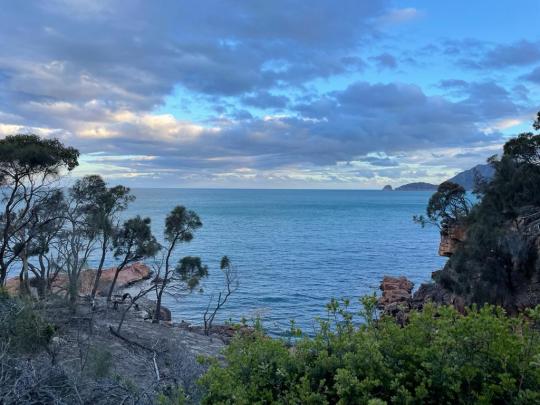
View from Freycinet Lodge in Freycinet National Park
Overview
My candid tl;dr: Tasmania is pretty, but not as stunning as nearby New Zealand. Given what a long trip it is from the U.S., I’d only prioritize traveling this far again for New Zealand.
Tasmania is an Australian island off the southeast coast of the continent. I visited with my parents in November, which is springtime – shoulder season so not crowded, but still a bit cold and windy.
The highlight for me was that every local person we interacted with was so incredibly nice. There was also some neat wildlife that I haven’t seen anywhere else – wallabies, paddy melons, wombats, kangaroos. And bathrooms everywhere were so clean – I’m talking Japan levels of clean!
We did a 1-week road trip starting in the capital city, Hobart, and driving out to two national parks: Freycinet National Park and Cradle Mountain National Park. We ended in the scenic town of Launceston. Each one of these spots had its own charm -- my favorite was Cradle Mountain because it was so pretty and full of wildlife. More on each spot below.
Disclaimer: This blog post is light on discussion of logistics because I did not plan this trip – I just tagged along with my parents.
Hobart

Hobart Harbor
Hobart is the capital city of Tasmania. It’s a ~2 hour flight from Sydney, and it’s also possible to fly there or take a ferry from Melbourne.
I spent 3 nights / 2 days in Hobart and did 2 day trips – one to Bruny Island for some brief, scenic walks (a ~2 hour drive each way, including a ferry) and the other to Port Arthur to tour an old penitentiary site and eat treats at a lavender farm along the way (a ~90 min drive each way, no ferry). Both were fine, but not exactly what I look for on travels (too much driving and touristy stuff vs. longer, scenic hikes), so I’d skip them if I went back.

Bruny Island coastline

Eagleneck coastline area near Port Arthur
If I were to organize one perfect day in Hobart, it would look like this:
Stay at the Macq01 hotel along the harbor – it was a super cute and well appointed boutique hotel with wonderful staff and a convenient location. One of the best hotels I’ve stayed at in recent memory
Sail on the harbor – we didn’t do this, but it looked picturesque and we saw signs for sailing excursions right outside the Macq01 hotel
Walk (~25 mins) or drive to the botanical gardens – these were some of the nicest gardens I’ve ever seen and entry is free
Eat Thai food at Bite Me (~10 min drive from the hotel, plenty of vegetarian options)
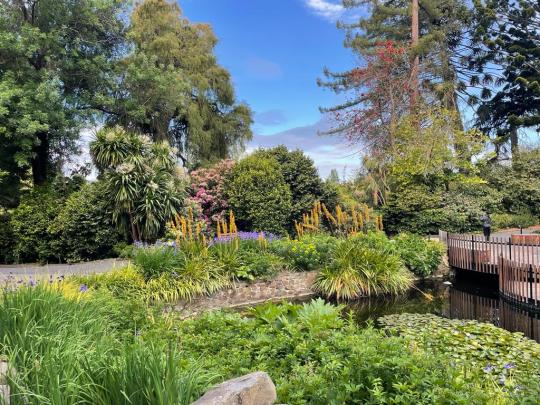

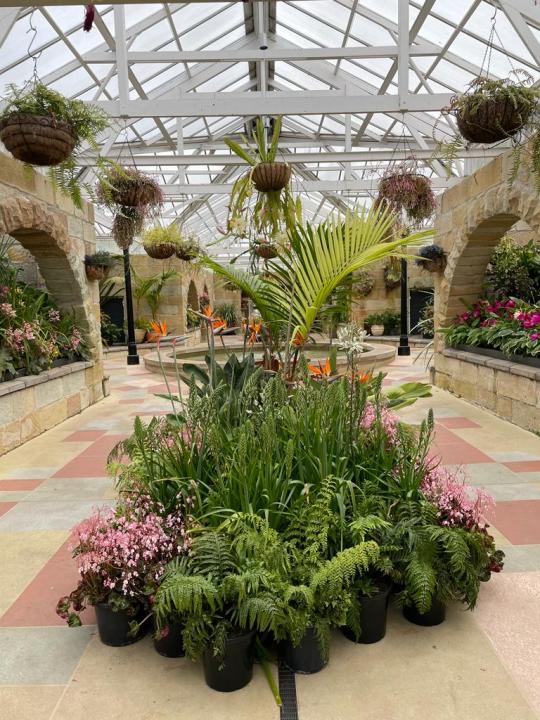
Hobart's botanical gardens stole my heart
Freycinet National Park
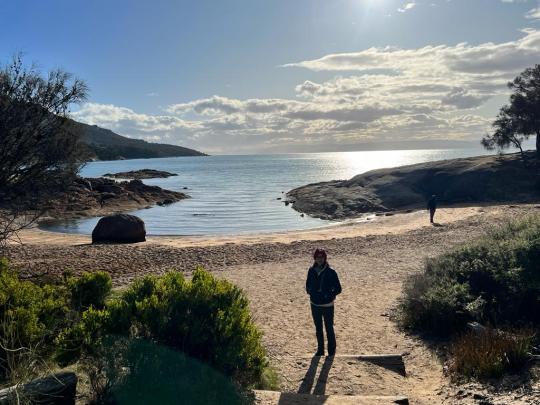
On the beach near Freycinet Lodge
This national park is a ~3 hour drive northeast from Hobart. It’s nice and reminded me of parts of the California coastline like Mendocino, Bodega Bay, Carmel, or Monterey, but it doesn’t compare to some of the most scenic places we’ve visited (e.g., New Zealand, Norway, Switzerland, our favorite parks in the U.S.). I’d go if I were nearby and for some reason couldn’t easily make it to New Zealand. So if you find yourself in the area, here are my recommendations:
Stay at Freycinet Lodge – We got a cabin and it was very comfortable, if not fancy like Macq01. The highlights are the location on the water and the food, which was excellent. And of course, like everywhere we visited, the staff were super nice.
Kayak with Freycinet Paddle – We enjoyed our 3 hour kayaking expedition and thought the guides were very nice and helpful. We got super lucky to have nice weather with a sunny day – the guides mentioned that just the day before it was very windy and cold, and people couldn’t feel their hands. It’s probably a safer bet weather-wise to do this a bit later in the season. We got lucky and saw dolphins!
Walk at Cape Tourville – This ~15 min, mostly flat walk was a ~10 min drive from our hotel and had stunning views of the ocean.
Walk to the Wineglass Bay Lookout – This ~90 min walk was a few minutes’ drive from our hotel and also had very nice ocean views. It’s definitely not hard, but there are some steps and there is no shade, so it’s nicer to do it in the morning or evening to avoid the harsh sun.
There may be some other, longer hikes as well – I’d have loved to explore more had the group been up for it.

Kayaking at Freycinet National Park

Wineglass Bay Lookout
Cradle Mountain National Park

We saw loads of wallabies on the side of the road at Cradle Mountain National Park (and a few at Freycinet, too)
We drove ~4 hours from Freycinet National Park to Cradle Mountain. Since Cradle Mountain isn’t exactly known for its food, we stopped along the week to pick up sandwich materials. The drive felt a bit tedious and the road is very windy towards the end, but once we finally arrived I really enjoyed the scenery and the following walks:
Dove Lake Circuit – This is a ~7 km, mostly flat walk around Dove Lake inside the national park. The vegetation around the water is quite unique and pretty. It reminded me a bit of the Jenny Lake walk at Grand Teton National Park, except the Dove Lake loop was much shorter.
Logistical note: You can park at the Visitor Center, buy a 72-hour shuttle ticket for AUD $15 pp, and take the shuttle ~20 mins to the last stop (Dove Lake) to start this walk. Shuttles were running every 10-15 minutes when we were there, and as it wasn’t super crowded we didn’t have any difficulty getting on a shuttle.
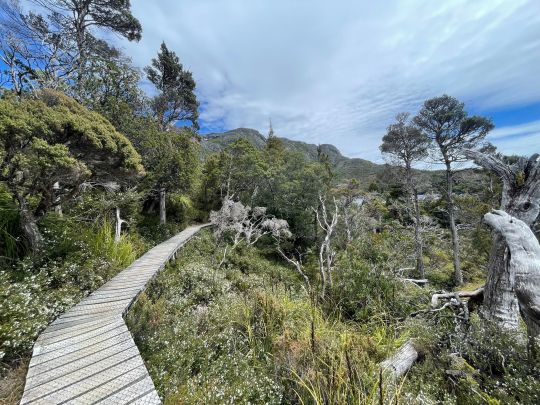
Dove Lake circuit -- most of the walk is on a well-maintained boardwalk
Enchanted Walk – This is a ~20 min roundtrip walk that is super pretty, mossy, and otherworldly. It reminded me of a walk we did at Olympic National Park.
Logistical note: You don’t have to take the park shuttle to access this one (though you can if you want). You can drive your car past the park visitor center and park at the ranger station to start the walk.
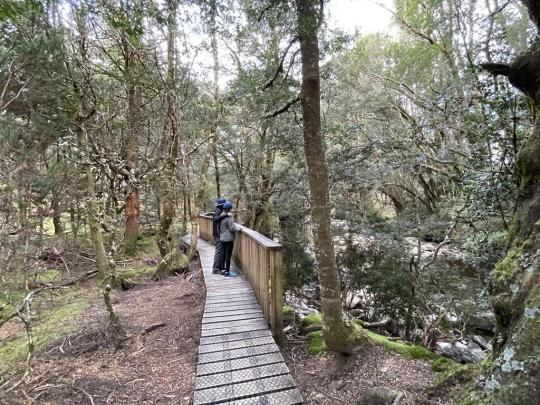
This photo definitely doesn't do justice to the Enchanted Walk
King Billy Trail – This is a ~40 min walk that starts right by the Enchanted Walk. We only walked ~10 mins of it in the evening, but we saw a kangaroo and a wallaby in just that short time. It seemed like a really nice trail as well.
The park has many more trails which I didn’t get a chance to explore, but which seemed really nice.
Eat at the dining room at Peppers Lodge. Vegetarian food options did not seem strong in the Cradle Mountain Area, but I was appreciative of the salad options at Peppers. Looking out the window from the dining room, we saw quite a few wallabies running around at night!
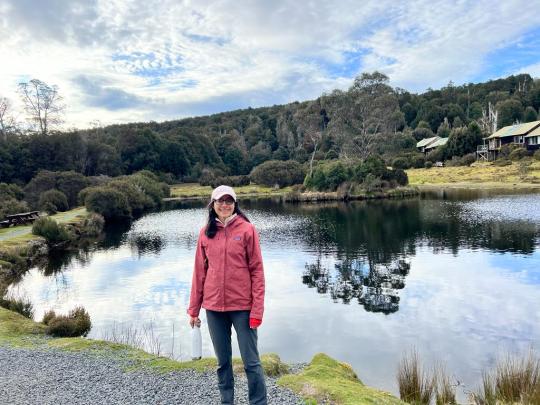
Outside Peppers Lodge
We stayed at the Cradle Mountain Hotel, which was a bit sad – more expensive and less nice than anywhere else we stayed in Tasmania. This reminded me a bit of the U.S., where the level of niceness of National Park lodges often seems inversely proportional to the surrounding scenery. It’s not clear to me that there are nicer housing options in the area, and the hotel was okay, but it’s worth checking if you visit.
Launceston
I didn’t have much time in Launceston, but we did a ~2 hour stop at the Cataract Gorge Reserve which was quite nice. There were some walking trails, a lake, a café and benches for picnicking, a playground for children, and peacocks, wallabies, and birds. Parking was AUD $6.

Cataract Gorge -- the chair lift is also an option to see it aerially
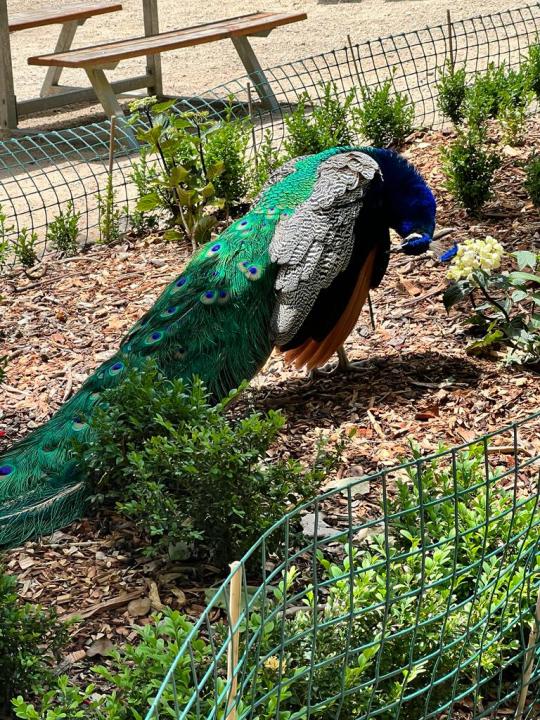
Peacock at Cataract Gorge
My parents spent a night at the Mantra Charles Hotel in Launceston, which I stopped by for a bit before my flight to Sydney. The room was about as small as a standard NYC hotel room and looked a bit dated, but it seemed fine. I’m not sure what more there is to do in Launceston, other than being a convenient spot to end a Tasmania road trip.
1 note
·
View note
Text
East Coast Tasmania
This is the area I have been to in the past but I didn't manage to get to Freycinet National Park with its famous Wineglass Bay so this was our first stop today, 3 hours after leaving Hobart. It was certainly hot and I think if I had realised the number of steps required to get to the viewpoint I might have baulked at it, but we did it and it was worth it.
Then it was onwards to Bicheno, where I have stayed before and the blowhole - not as impressive in summer as I recall from my winter visit, and then on up the east coast to our stopping point at St Helen's, just south of the Bay of Fires National Park. WE probably had the most helpful receptionist of all our trips thus far and she made some suggestions of where to go as well as eateries, so after stuffing ourselves with seafood we went out to St Helens point seeing beautiful scenery, some magnificent dunes and pelicans and then we headed up towards the Bay of Fires but I don't recall the area that we visited today and the boulders and red lichen were certainly not as impressive as where I had seen them previously - I just wish I could recall the exact spot. However, the light on the rocks does make them glow red and it was worth seeing.
Last day in Tas tomorrow sadly.
0 notes
Text
Exploring the Wilderness: Unveiling the Beauty of Cradle Mountain Tours
Nestled in the heart of Tasmania, Australia, Cradle Mountain stands as an iconic testament to the pristine beauty of the wilderness. Offering a symphony of alpine landscapes, ancient rainforests, and crystal-clear lakes, Cradle Mountain Tours beckon nature enthusiasts and adventure seekers alike. In this article, we will embark on a virtual journey through the enchanting wonders of Cradle Mountain, delving into the captivating experiences that await those who choose to explore this natural masterpiece.
Cradle Mountain Overview:
Cradle Mountain is a part of the Tasmanian Wilderness World Heritage Area, renowned for its diverse ecosystems and unique flora and fauna. The national park surrounding the mountain is a haven for outdoor activities and a sanctuary for those seeking a retreat into nature's embrace.
1. Iconic Landmarks:
Cradle Mountain: A jagged dolerite peak that stands proudly at 1,545 meters, offering panoramic views of the surrounding landscapes.
Dove Lake: Nestled at the base of Cradle Mountain, this glacial lake reflects the towering peak, creating a mesmerizing mirror effect.
2. Wildlife Encounters:
Wombats: These charming marsupials are a common sight, leisurely grazing in the open grasslands.
Tasmanian Devils: Encounter these unique carnivorous marsupials, often spotted during the twilight hours.
3. Hiking Trails:
Overland Track: A world-renowned trek spanning 65 kilometers, leading adventurers through diverse terrains, ancient rainforests, and alpine meadows.
Dove Lake Circuit: A shorter but equally breathtaking trail, offering spectacular views of Cradle Mountain and its surrounds.
Cradle Mountain Tours:
1. Guided Wilderness Walks:
Expert Guides: Knowledgeable guides lead visitors through the park, sharing insights into the flora, fauna, and geological marvels.
Interpretive Walks: Discover the hidden stories behind the landscapes, from the ancient Aboriginal history to the tales of early European explorers.
2. Wildlife Safaris:
Nocturnal Tours: Experience the magic of the park after dark, as nocturnal creatures come to life under the Southern Hemisphere stars.
Photography Safaris: Capture the beauty of Cradle Mountain's wildlife and landscapes with the guidance of experienced wildlife photographers.
3. Adventure Activities:
Canoeing on Dove Lake: Paddle across the pristine waters of Dove Lake, surrounded by the majestic peaks of Cradle Mountain.
Cradle Mountain Canyoning: For the more adventurous, explore the hidden gorges and waterfalls through guided canyoning adventures.
4. Cultural Experiences:
Aboriginal Heritage Tours: Gain a deeper understanding of the traditional custodians of the land with tours that explore the rich Aboriginal heritage of the region.
Indigenous Art and Craft Workshops: Engage in hands-on experiences, creating art inspired by the natural beauty that surrounds Cradle Mountain.
Conclusion:
Cradle Mountain tours offer an immersive experience into the heart of Tasmania's wilderness. Whether you are an avid hiker, wildlife enthusiast, or someone seeking a tranquil escape, the diverse offerings of Cradle Mountain cater to all. As you traverse the iconic landmarks, engage in guided walks, and immerse yourself in the cultural richness of the region, you'll come to appreciate why Cradle Mountain stands as a jewel in the crown of Australia's natural wonders. Embark on a journey to Cradle Mountain, where every step reveals a new facet of nature's grandeur, leaving you with memories that linger long after the adventure concludes.
For more details, visit us :
Backpacker Tours Tasmania
Tasmania 4 day tour
Tasmania Private Tours
Wineglass Bay Tasmania tours
#Tasmania 4 day Hiking tour#Freycinet National Park hiking tour#Tasmania 4 day itinerary#how to visit cradle mountain
0 notes
Text
by dzittin on Flickr.Sleepy Cove in Freycinet National Park – Tasmania, Australia.

0 notes
Text
Days 6-8 of Australia vacation: East Coast of Tasmania
On Day 6, which was New Year's Day, we left Hobart, looking forward to more comfortable accommodations at our next destination.
We started by driving through an agricultural area, including a stop at a farm that produces cheese. We bought some cheese and chocolate at their shop and admired the views and the goat. We made a couple of stops to buy fruit from farm stands (cherries from a place where we just left the money in the tin; apricots and peaches from a more formal farm shop). I spotted a swamp harrier from the car! Another new bird for me. We then stopped for a break in a town called Richmond. It was quaint! We popped into a little craft market, where I bought a hook made from an old fork by an artist going by the name Dr. Spork, and then got ice cream cones on our walk to the Old Bridge. The stone bridge was picturesque, particularly because there were lots of ducks and ducklings around! Some of them were Pacific black ducks, which were new to me. Others were probably domestic hybrids.
The next stop was at Triabunna's Fish Van, where two of the group got crayfish for a late lunch. And then, back on the road to a beautiful eco-resort type place called Piermont Retreat.
After getting settled there, the others went to the resort's restaurant for a 5-course tasting menu. I'm a picky eater and knew it wouldn't be suitable for me, so I had instead ordered a bread/cheese/etc. hamper delivered to our cottage for my dinner. Before eating, though, I set out to explore the property, which was large and included some beach. Besides getting my feet sandy and wet, which I'd been wanting to do for a while, I spotted a bunch of new birds: European goldfinches, a black-faced cuckooshrike, many superb fairywrens, and a great cormorant. My dinner was delicious. And once the others returned from their delicious gourmet meal, we played Codenames.
Day 7 was a very long and full day. We woke up too late to go to the restaurant for breakfast, which closed at 10, but we had plenty of food with us to eat. Then we set off for Freycinet National Park to do the very popular Wineglass Bay Lookout hike. It was only 2 miles, but it was steep; the day was sunny and hot; and Sister-In-Law is still recovering from a flu. But we agreed that it was worth the sweat, because the views from the top--and even the views along the way-- were spectacular. Although I didn't see any new birds (and only 2 birds total), there was a beautiful black snake near the beginning of the hike. We later learned that all snakes in Tasmania are venomous, but of course we are smart enough not to go messing with snakes in Australia!
We decided, as long as we were in the park, to do another (shorter and easier) walk, so we drove over to the lighthouse and did the walk around there. More great views, though also a lot of wind, and I saw Pacific gulls, which have a very prominent and huge beak. I might have also seen a tree martin? I still struggle with swallows and swifts, but Tasmania doesn't have that many birds in those families, and it didn't look like a welcome swallow.
After that, we left the park and made a stop at a winery to do a tasting. I particularly enjoyed their dessert wine.
Next, we went to the town of Bicheno for dinner. Two of us got pizzas and two of us got crayfish at the Lobster Shack. From the deck there where we ate, we could see an islet close to shore that was positively covered in seabirds, including cormorants and terns, but it was so windy that I couldn't hold my binoculars steady enough to identify any of them. I did see a sooty oystercatcher on the beach below, though! I love oystercatchers. This one looked similar to the black oystercatchers we have in California, but I assume it's a different species as the name is different. We then visited the nearby blowhole before taking a walk in town while waiting for our penguin tour. I spotted a New Holland honeyeater! and we saw some of what were presumably burrows belonging to Little Penguins, but it was too early for the penguins to be returning to shore.
We then went to the pickup point for the penguin tour. It was a bit of a wait, but finally the bus took us to the protected area. I felt a bit concerned that perhaps we were disturbing the penguins--the place we went to in New Zealand to see them seemed stricter--but on the other hand, the local penguin population is much higher than it was before they created this protected area, so it must be better than it used to be, and we saw a lot of interesting penguin drama with parent penguins chasing other penguins away from their burrows but the older penguin babies trying to beg food from adults who were not their parents! All of which is apparently natural behavior. The guides only used red flashlights (penguins don't perceive red light) and instructed us how to stand so that the penguins could get past or go between our legs. The penguins were really ridiculously cute. But the tour started after 9pm and we were exhausted by the time we headed home! On the drive back, once we got onto the resort property, we saw wallabies and some other marsupials, and then a brush-tail possum tried unsuccessfully to get in through the open window of the cottage--it was pressing itself against the screen!
On Day 8, our main goal was to enjoy the Piermont Retreat and the surrounding area. It was overcast and cooler. I looked at birds from the deck and also did a little bird walk while waiting for the others to be ready to go. In addition to birds I'd seen before, I also spotted a brown thornbill (I think), a yellow-throated honeyeater (another endemic), a pied oystercatcher, a silvereye, and a very beautiful eastern spinebill.
We went to Kate's Berry Farm, which appeared to be more cafe than farm, but they served delicious scones with lots of berry jams and clotted cream. Then we went into town (Swansea) to scope out dinner options. That took longer than I really wanted it to, but I saw some birds as we walked around, including 2 I hadn't seen yet: a laughing kookaburra and a European greenfinch.
After a quick stop at the accurately-named Spiky Bridge, we returned to the cottage to spend the rest of the afternoon exploring the property. Wife rode a mountain bike, the In-Laws took a sea kayak out (only briefly; I would've joined them if we'd done it earlier in the day when the water was calmer), and I did another bird walk, during which I saw some more new birds: gray fantails and hooded plovers. The scenery was beautiful and I found some idyllic spots. Then I went for a dip in the unheated saltwater pool, which was fortunately warm after several sunny hot days. The In-Laws joined me and it felt very vacationy!
We picked up take-out for dinner and then played a game before packing and going to bed, feeling sorry we couldn't stay longer at this lovely spot!
9 notes
·
View notes


